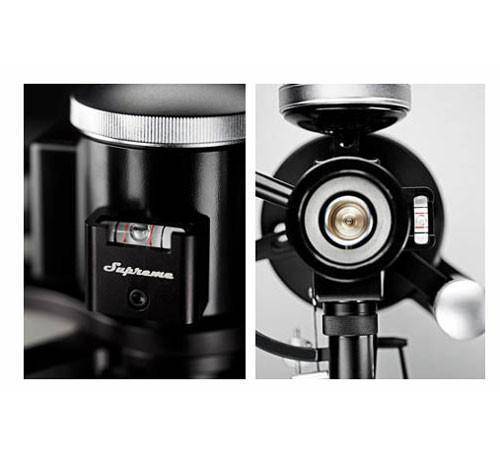Graham Phantom II Supreme 9" 10" or 12" Tonearm
Graham Phantom II Supreme 9" 10" or 12" Tonearm
Product questions? Found a lower price?
Let us know: 909.931.9686 or chat.
This item qualifies to earn HiFives. What's a HiFive?
View full details

The original Phantom Model B-44, recepient of the "Editor's Choice" Award from Harry Pearson (October 2006 issue of TAS), a Class "A" rating in 2005 from Michael Fremer, and runner-up for both Analog Source Component AND the 2006 Product of the Year award in Stereophile, was our first really new design following the award-winning 2.x series arms. The Phantom significantly advanced tonearm performance significantly from the then-current state of the art.
Three years later, we offered the improved Phantom II. The acclaim and awards continued, with TAS naming it "Tonearm of the Year (2009). Harry Pearson placed it twice as his Editor's Choice (2009 and 2011), and Michael Fremer again assigning the improved Phantom II in the "Class A" ratings.
And now, with the introduction of the Phantom II SUPREME, our newest and most advanced design ever, we believe you will agree that this really is the most practical and finest tonearm you can buy today. Some improvements:
- New bearing housing incorporating Tungsten inserts for better mass coupling
- New bearing housing features reduced resonance for improved dynamic range
- New counterweight features smaller diameter for increased turntable compatibility
- New counterweight accommodates heavy phono cartridges
- New CA-5 cartridge alignment gauge incorporates vertical adjustment to optimize for different height phono cartridges
The Phantom II SUPREME The original Phantom and upgraded Phantom II tonearms have enjoyed an enviable record of performance, build quality, and user satisfaction. When we set about to improve on what was already a high standard, we knew any changes must be significant, and provide even more insight into the subtle layers of musical detail.
And now the Phantom II SUPREME - our newest and best effort to date - has exceeded our highest expectations, surpassing even the highly-rated Phantom II.. And when compared to other tonearms on the market, tests and preliminary user comments have confirmed that the Phantom II SUPREME is in another, altogether higher level of performance.
Compared to the orignal Phantom, as well as the Series II, the SUPREME has a similar outward appearance, but has important internal differences. In addition to the refined Magneglide (tm) stabilizer, new internal wiring for even better detail and improved freedom from any mechanical resistance, an upgraded pivot design for even greater dynamics, and a new titanium armwand, the SUPREME has incorporated a new pivot housing assembly.
This assembly, comprised of a constrained layer combination of brass and tungsten, provides greater energy control and damping, along with improved bearing peformance. Incorporating a slightly reshaped counterweight to allow for great cartridge weight ranges and lower moment of inertia, the result is greater transparency, broader soundstaging (both side to side and front to back), with greater bass impact and extension.
Combined, these refinements yield greater performance in the areas of thundering dynamics and sheer musicality, while retaining the delicacy of detail, quality and convenience features the earlier Phantom was noted for.
The reasons for these and other significant improvements are many, and are covered in three patents, with other applications pending. The armtube itself, easily removable and using our patented alignment system, offers the safety, convenience and accuracy of off-turntable cartridge installation and alignment, as well as allowing quick interchange of multiple pre-mounted cartridges. It is significantly improved from the earlier armwands, and attaches to a nearly half-inch wide stainless-steel post-and-connector that supports the armwand under tension, resulting in virtually a one-piece armtube/pivot assembly with high damping.
Secondly, we've addressed the all-important (and often ignored) area of dynamic balance. Tonearms should have as little inertia as possible; yet, too often, as a result of the correct placement mass distribution being overlooked, they contribute excessive resisting forces in opposition to the requirements of the phono cartridge as it attempts to follow the ups and downs of a typical record. The Phantom, in spite of its robust appearance, has been designed with a very low moment of interia, so that the majority of phono cartridges can be used with ease and maximum performance.
At this point, a brief description of Balance Theory may be helpful: There are basically three types of static balance systems, Neutral, Stable, and Unstable.
STABLE BALANCE, normally seen in laboratory scales, occurs when the CG (center of gravity) of the moving system is placed BELOW the pivot point. This system resists a change in postion; when a tonearm utlizes this type of system, and such a tonearm is displaced from its preferred rest position, it will generate an immediate and opposing force which tries to return to that same position.
UNSTABLE BALANCE, when the center of gravity is placed ABOVE the pivot point, is entirely useless for tonearm design, and will exhibit serious problems, including reduced tracking force as the arm is raised.
The third, and most desirable system for tonearms, is NEUTRAL BALANCE. With this system, the pivot point and the Center of Gravity of the moving system are in the same plane. When the arm is raised or lowered, there is no opposing force trying to return the arm to a rest position; the pivoting system doesn't really know or care if the stylus is at the record surface level or a half-inch above or below it; as a result, there is no opposing force to the arm as it is traversing record deflection during play. The only downward tracking force is that of the adjustable counterweight, which remains a constant. Previously, all true unipivots - that is, those with a single contact point for the bearing and NO secondary stablizing surfaces, bearings, etc. - required the use of side weights or a significantly lowered counterweight in order to provide stability. And generally speaking, those arms with a secondary stabilizer point require a lowered center of gravity in order to provide constant contact with the stabilizer guide bearing.
The drawback to both these conditions is that this design becomes a Stable Balance system, which will cause a tonearm to have a preferred rest position and always tries to return to this point. ANY time the tonearm is raised, as in tracking warped records, it results an immediate and equally opposing force that tries to push the arm back to its rest position. The higher the warp, the more counter-force is applied.
This unalterable Law of Physics will work against the cantilever, deflecting it during warps and causing the magnetic system inside the cartaridge to be displaced. This, in turn, will certainly affect the reproduced sound, with diminished performance in all areas, including soundstage compression, loss of detail and dimensionality, not to mention record wear. (This is why most tonearms must have their tracking force measured at the record surface level; any height change during the measurement will cause an incorrect reading).
A tonearm with Stable Balance can be identified by measuring the tracking force at the record surface level and again at a raised position above the record. If the tracking force INCREASES at the higher position, the arm has Stable Balance. Our own previous designs - the best we could make at that time - also had this limitation due to the use of side weights to provide lateral stability.
Other unipivots with low-slung counterweights will all exhibit this force; the lower the weight, the more counter-force is applied. Although this technique is often promoted as a "high-stability" design, it does so at the expense of consistent tracking force and linear cartridge performance. . It actually results in varying tracking forces during play when traversing even small warps, accompanied by non-linear cartidge operation, and increased record wear.
Once Neutral Balance is chosen for use in a unipivot tonearm, one must remember that both the vertical and lateral planes will be affected the same way; without proper lateral stability, such a design would not have consistenent, proper vertical alignment, and the pivot would tend to flop over to one side or another (usually in the direction of the weighted cartridge offset angle mounting). Obviously this condition must be avoided.
The answer to this lies at the very heart of the Phantom's design and its unique ability to retrieve groove information unprecended, we believe, in tonearm design. The key to this achievement is a magnetic stabilization system which we have called "Magneglide" (TM). With this unique, patented system, all lateral stability, and a portion of the damping, is provided by powerful neodymium ("rare-earth") magnets, placed in a horizontal line from the pivot point of the tonearm.
Working as an adjustable system, Magneglide (TM) provides the following six benefits: increased lateral stability, easy azimuth adjustability, a higher intertial lateral component for improved bass reproduction, augmentation of system damping, true vertical pivoting of the stylus tip with no rotation as the arm is raised, and easily adjusted anti-skate compensation.
In combination with pivot fluid damping (similar to that used with the Model 2.2), the Magneglide (TM) system allows normal vertical pivoting of the tonearm in true Neutral Balance, with vanishingly low friction; yet, provides a strong lateral stability that feels almost like fixed bearing arms. (No wobbling of the arm as it is lifted, for instance).
In addition, this dual-damped system forces the Phantom to pivot in the correct vertical plane of the stylus tip, with no rotation as the arm is raised. No regular unipivot can achieve this important geometric requirement. Even a few fixed bearing arms don't get this right!
If the vertical motion of the tonearm is in plane of the armtube itself (and not the correct plane of the stylus face angle), the cartridge will tend to tip over to its side as the arm is raised, as when tracking over warps. This will cause noticeable channel imbalance and reduced tracking accuracy.
With the patented Magneglide (TM) design, we have a high-load, chatter-free and virtually friction-free damped unipivot bearing, combined with true Neutral Balance, and with the all-important geometric accuracy of correct vertical pivoting parallel with the face of the stylus tip.
If all that weren't enough, the Magneglide (TM) system also permits the application of anti-skate through the magnetic coupling of the design, thereby eliminating ANY direct contact or possible resonance to affect the main pivot assembly of the tonearm. The anti-skate system is completely independent, mechanically, and is easily adjusted either by a thumb-wheel rotation or sliding motion (user's choice) of the bias weight for minute adjustments from near zero force to 3+ grams.
If your turntable already had a Graham tonearm on it (to get the angles correct), the Phantom is a true "drop-in" replacement. Although turntable manufactuers understandably encourage you to use tonearms of their own manufacture, this is not necessary; the modifications to make the Phantom fit are relatively easy, and we provide customer assistance in this area when needed.
As part of our design tradition, we maintain an upgrade path so that even the earliest Phantom B-44 model can be brought up to the current Phantom II SUPREME status.


